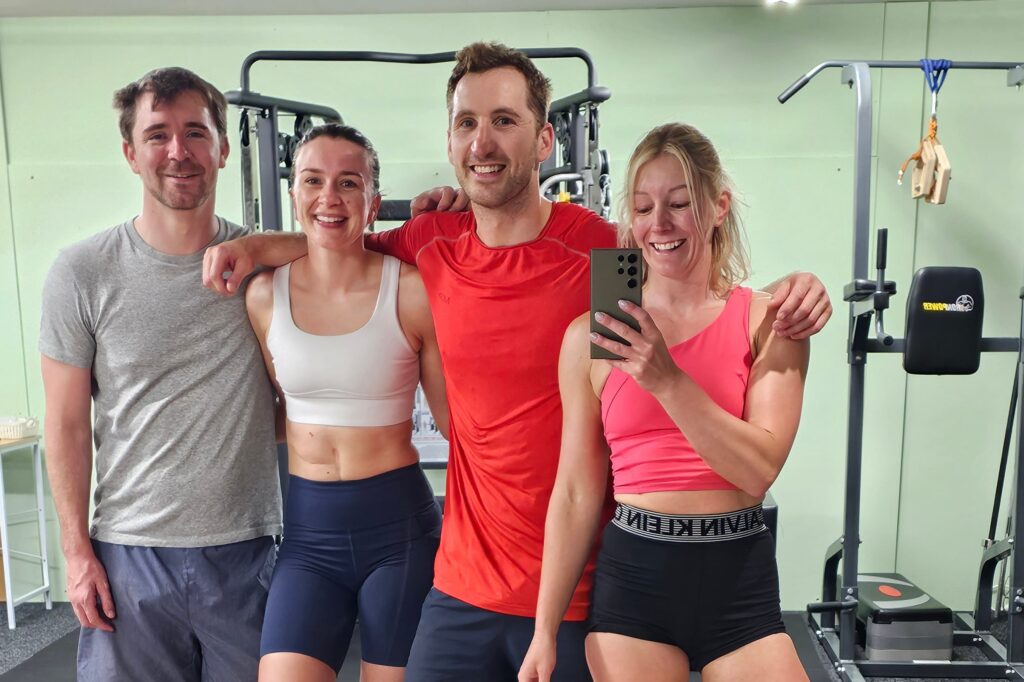How to Set SMART Workout Goals, and Actually Achieve Them!
If you think setting your own workout goals is easy – I’m sorry but, you’re probably not doing it right.
We’ve all had those bursts of motivation where we set vague goals of exercising daily, eating clean, and transforming our fitness. But without a solid plan, that motivation fizzles out fast. Many of us have experienced this pattern over and over again for years. Are you ready to break the cycle?
As a personal trainer, let me help you set SMART fitness goals and actually achieve them. SMART goals are Specific, Measurable, Achievable, Relevant, and with a Timeframe. Don’t worry if all of that feels a bit overwhelming, I’m here to guide you through. This method of goal setting takes some effort and preparation, but you’re much more likely to stay the course and see the results you want.
I’ve seen first-hand what a difference it makes when my clients set SMART goals. If you want to set fitness goals that you’ll not only start but actually smash, here’s how:
1. Specific
The first step for SMART goal setting is to be specific. Because honestly, vague goals simply will not cut it. Saying, “I want to get fit” or “I want to lose weight” is a great starting point, but what does that actually mean for you? The more specific your goal, the easier it will be to create a plan and track your progress.
For example… Instead of saying, “I want to get stronger,” set a goal like, “I want to deadlift my own body weight within three months.” Or… If weight loss is your goal, instead of “I want to lose weight,” try “I want to lose 5kg by before my holiday in June.” This gives you a clear target to work towards and makes it easier to create an action plan.
2. Measurable
The ‘M’ encourages you to set measurable goals. If you don’t track your progress, how will you know if you’re improving? At QTPT I keep a record of all your workouts to keep you accountable and so we can see how far you’ve come… And celebrate!
Ways to track progress:
- Keep a workout journal and write down your exercises, weights, reps, and times.
- Use a fitness app to log your runs, steps, or workouts.
- Take progress photos in the same outfit and lighting.
- Measure your body composition, like waist circumference or muscle mass, rather than relying solely on the scale.
- Set mini-goals, like increasing your squat weight by 5kg each month or shaving 30 seconds off your 5k run time.
Tracking your progress gives you tangible proof of improvement, which is a huge motivator when you feel like you’re not getting anywhere.

3. Achievable
The achievable element of SMART goal setting refers to the balance between challenging yourself and staying sensible. It’s great to aim high, but setting unrealistic goals will only lead to frustration and burnout. Instead, we work together to set goals that challenge you and push your limits without overwhelming you or becoming unsafe.
Example 1: If you haven’t exercised in months, deciding to work out six days a week right away is probably not sustainable. Instead, start with three 30-minute sessions per week and gradually build up as your fitness improves.
Example 2: Similarly, if your goal is to do 10 pull-ups but you can’t do one yet, you can start by practicing with inverted rows, assisted pull-ups, negative reps, and grip strength exercises. Don’t worry, I can teach you these safely and guide you through the process.
Progress happens step by step, and setting achievable milestones will keep you motivated.
4. Find Your “Why” – Make It Matter
Understanding why you want to achieve your goal is crucial. Your ‘why’ should be meaningful enough to keep you going when motivation dips.
Examples of strong “whys”:
- “I want to feel strong and energetic so I can keep up with my kids.”
- “I want to improve my cardiovascular health so I can reduce my risk of heart disease.”
- “I want to build confidence in my body and feel good in my clothes.”
Once you have a clear reason, write it down and remind yourself of it daily. When you’re tempted to skip a workout or give up, revisit your ‘why’ and use it as motivation to keep pushing forward.

5. Build a Routine – And Stick to It
Willpower can be great, but it easily wains and is unreliable. Habits are what truly create long-term success. If you can integrate fitness into your daily routine so that it becomes as automatic as brushing your teeth… My friends, you’ve cracked it!
Tips to build a routine:
- Schedule your workouts like meetings—put them in your calendar and treat them as non-negotiable.
- Plan your workouts for a time that suits your natural energy levels. If you’re a morning person, get it done first thing. If you have more energy in the evening, schedule it then.
- Pack your gym bag the night before so you have no excuses.
- Pair your workout with an existing habit. For example, if you always have coffee in the morning, commit to doing 10 minutes of stretching or bodyweight exercises right after.
- Have a backup plan! If you can’t make it to the gym, have a go-to home workout ready.
The more consistent you are, the easier it becomes to make exercise a part of your life.
6. Celebrate the Wins – Big and Small
Recognizing your achievements keeps you motivated and reinforces positive habits. Many people only celebrate big milestones, like reaching their goal weight, but celebrating small wins is just as important.
Ways to celebrate progress:
- Treat yourself to new workout gear when you hit a milestone.
- Take a rest day and enjoy a relaxing activity, like a massage or a long bath.
- Share your progress with a friend or on social media for accountability and encouragement.
- Reflect on how far you’ve come—look back at your first workouts and compare them to where you are now.
Acknowledging progress, no matter how small, keeps you engaged and excited about your journey.
The Takeaway
Fitness isn’t about perfection—it’s about consistency and progress. I often tell my clients, the workouts don’t get easier, because you get stronger, and we push further.
Setting SMART goals gives you a roadmap, but it’s your daily habits and mindset that will determine your success. Break down big goals into manageable steps, track your progress, and stay connected to your motivation. Most importantly, enjoy the journey and celebrate every step forward!
Now, go set those goals and start smashing them! Need help getting started? Let’s chat—I’d love to help you reach your fitness potential!

5 reasons a personal trainer is better than just a gym membership
A personal trainer can not only improve your gym membership experience but also the value for money too…
